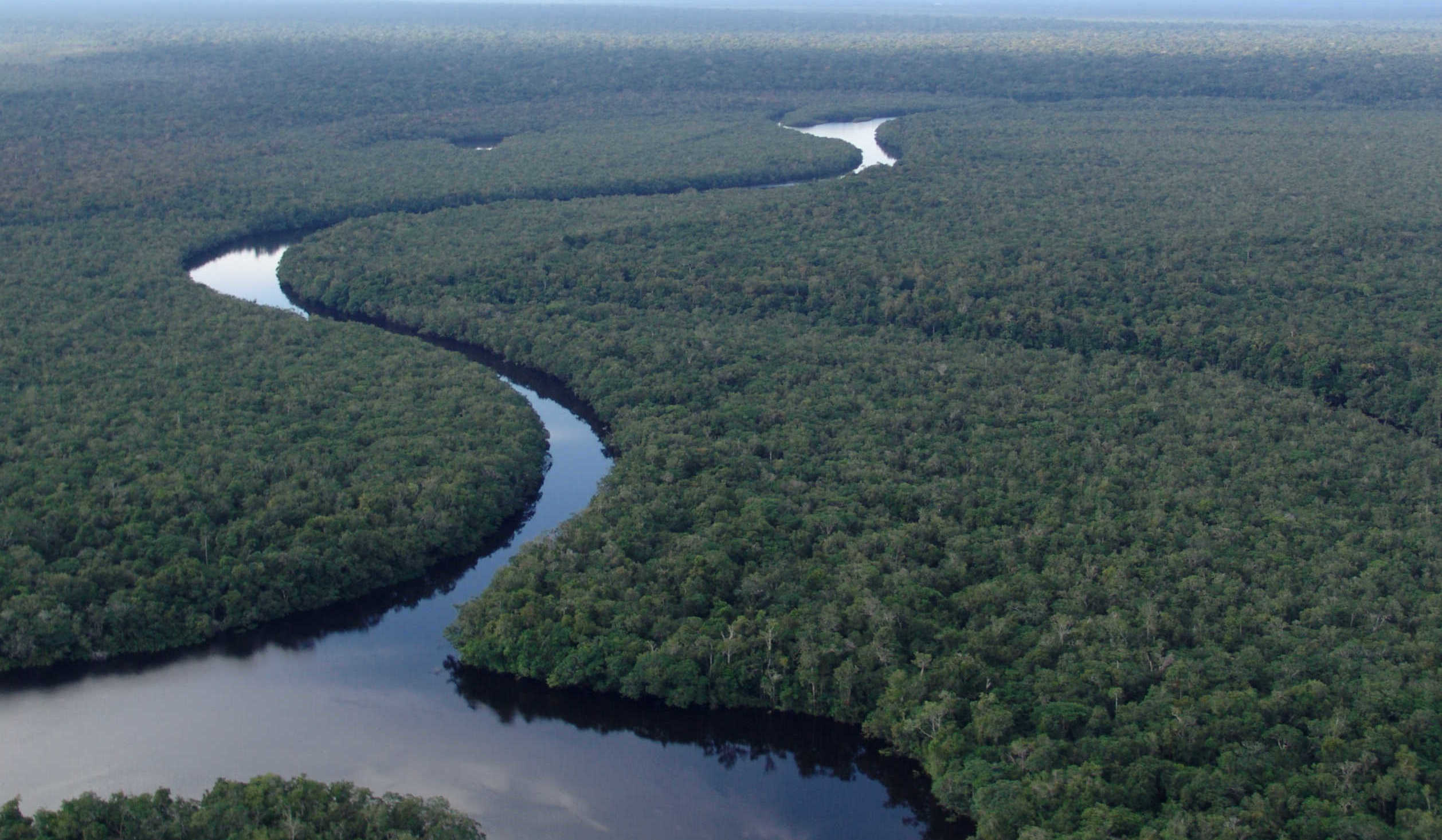
Biogeografia
Historical Biogeography of birds from the “Brejos de Altitude” of northeastern Brazil: understanding past connections between the Atlantic Forest and the Amazon
There are very few studies in northeastern Brazil, a region that is home to a variety of environments used to propose hypotheses and models of diversification, but have not had an empirical contribution to advance on these discussions, particularly with the contribution of molecular biology. In northeastern Brazil, forest refuges are result from processes of expansion and shrinkage of forests during climate fluctuations and were cited as the hypotheses to explain the occurrence of disjunct rainforest of the Amazon, in the coastal region, as well as forest enclaves of mountains located in the area of Caatinga, a semi-arid region. These enclaves, known as Brejos de Altitude occur between c. 500 and 1,100 meters above sea level, where orographic rains ensure higher levels of rainfall to 1200mm / year. Some authors suggest that the Brejos de Altitude were part of one of the corridors connecting the Atlantic Forest and Amazon during the warmer periods of the Plio-Pleistocene. However, phylogenetic and phylogeographic studies suggest that the connections between the Atlantic Forest and Amazon occurred in different geological periods from the Miocene, c. 26 Ma, which raises questions that support the Brejos de Altitude as an unique biogeographical entity. The difficulty to test these hypothesis is associated with the limited availability of material covering the entire distrution of the Brejos de Altitude and other related areas for use in molecular analyzes. Moreover, these environments are considered the most endangered in the Atlantic Forest and factors that generate these threats are still occuring today. Which may compromise the future existence of the organisms that can be used as evidence for the above studies. In recent years several studies have shown the importance of integrating phylogenetic information on conservation programs. For example, the combination of dated phylogenies with models of distribution of the organisms allow us to understand the effects of climate change in the past, and use them for planing the conservation in the face of current and future climate change. Studies of molecular phylogeny and distribution modeling have shown that different bird species respond differently against climate change. The information of how species have responded in the past against the intense climate change can be used to study the degree of susceptibility and response of biota to current and future climate change. This knowledge have a fundamental importance in the context of global warming already observed and expected for several regions of the planet. Therefore, is essential to the development of public policies to mitigate the effects of these changes on biodiversity.The aim of this study is to investigate different groups of birds to understand the current disjunct distribution (ie the Atlantic Forest, the Amazon and the Brejos de Altitude is the result of a single large event of fragmentation / connection of tropical forests during the Pleistocene, different events of fragmentation in different periods of global cooling, or long-distance dispersal events. For this, ecological approaches (niche modeling) will be integrated with evolutionary approaches (historical scenarios testing diversification through Approximate Bayesian Computation and Theory of coalescence).
Origem da diversidade de aves da Caatinga e sua relação com outros biomas Neotropicias para subsidiar ações de conservação
A região Neotropical abriga mais espécies do que qualquer outra região tropical. Durante várias décadas, os pesquisadores têm procurado principais explicações para essa riqueza de espécies e muitos modelos de diversificação foram propostos. No entanto, tornou-se evidente que a alta biodiversidade Neotropical não é o resultado de um único evento histórico ou processo de diversificação. Diferentes regiões e biomas têm histórias, padrões de riqueza de espécies e taxas de diversifição muito diferentes. As causas subjacentes de tais diferenças são complexas, mas podem estar relacionadas a história geológica, taxas de dispersão entre os biomas seguido por diversificação in situ e interações ecológicas. Assim para que se tenha uma melhor compreensão da região Neotropical é importante que seja feita uma análise ambrangente estudando diferentes biomas e ambientes. Portanto esta proposta tem como finalidade fazer um avanço fundamental no conhecimento dos processos que determinaram os padrões de diversidade na região Neotropical para uma melhor compreensão do tempo evolutivo e taxas de especiação analisando linhagens de aves em diferentes biomas. Pretende-se fazer uma avaliação em grande escala da importância relativa de fatores ambientais na diversificação das aves neotropicais utilizando sequenciamento e modelagem de nicho.
Filogeografia comparativa de aves das vegetações abertas da América do Sul com ênfase nas campinas da Amazônia
A floresta Amazônica é cercada por duas grandes áreas de vegetação aberta, a Gran Sabana na região das Guianas e o cerrado do Planalto Central do Brasil. Entre essas duas regiões existe grande similaridade na composição de espécies. Acredita-se que essa similaridade taxonômica se deve a mudanças climáticas do Pleistoceno, assumindo-se que a floresta amazônica se retraiu e fragmentou, facilitando o intercâmbio biótico durante períodos glaciais. Atualmente manchas de áreas abertas estão presentes também no interior da floresta amazônica (campinas e campinaranas), no litoral Atlântico e na base dos Andes. Não se sabe ainda se as espécies da Gran Sabana e do cerrado estão isoladas ou conectadas geneticamente. São propostos três corredores de dispersão entre essas duas grandes regiões: 1) corredor oeste (base dos Andes); 2) corredor central (campinas e campinaranas); 3) corredor leste (restingas do Atlântico). Neste contexto as campinas e campinaranas são áreas de interesse especial a serem estudadas devido a sua distribuição insular, alto endemismo de espécies e por serem o habitat menos estudado na Amazônia. Este projeto tem como objetivo estudar as relações filogenéticas entre espécies e populações de aves presentes nas áreas de vegetação aberta na Amazônia (campinas amazônicas) e nas regiões adjacentes: o cerrado do Planalto Central do Brasil, a Gran Sabana na região das Guianas, as restingas do litoral
Publicações
- Cohn-Haft, M., Naka., L.N., Fernandes, A.M. (2007) Padrões de distribuição da avifauna da várzea dos rios Solimões e Amazonas. In: Conservação da várzea: identifcação e caracterização de regiões biogeográfcas (ed. by A.L.K.M. Albernaz), 287–323, Ibama/ProVárzea, Manaus, Brazil.
- Cohn-Haft, M., Pacheco, A.M.F., Bechtoldt, C. L.,Torres, M. F.N., Fernandes, A.M., Sardelli, C. H., Macêdo, I. T. (2007) Inventário ornitológico. In: Biodiversidade do médio Madeira: Bases científicas para propostas de conservação (ed. by L.R. Py-Daniel, C.P. Deus, A.L. Henriques, D.M. Pimpão, M.O. Ribeiro), 145–178. INPA, Manaus.
- Fernandes, A.M.; Wink, M.; Aleixo, A. (2012) Phylogeography of the Chestnut-tailed Antbird (Myrmeciza hemimelaena) clarifies the role of rivers in Amazonian biogeography. Journal of Biogeography, 39, 1524–1535.
- Fernandes, A.M.; Gonzalez, J.; Wink, M.; Aleixo, A. (2013) Multilocus phylogeography of the Wedge-billed Woodcreeper Glyphorynchus spirurus (Aves, Furnariidae) in lowland Amazonia: Widespread cryptic diversity and paraphyly reveal a complex diversification pattern. Molecular Phylogenetics and Evolution, 66, 270–282.
- Fernandes, A.M. (2013) Fine-scale endemism of Amazonian birds in a threatened landscape. Biodiversity and Conservation, 22, 2683–2694.
- Cohn-Haft, M.; Junior, M.A.S.; Fernandes, A.M.; Ribas, C (2013) A new species of Cyanocorax jay from savannas of the central Amazon. In: Handbook of the birds of the world, Special Volume: New Species and Global Index. (ed. J. del Hoyo, A. Elliott, J. Sargatal, D. A. Christie), 48–53. Lynx Edicions, USA. ISBN-13: 978-84-96553-88-0.
- Aleixo, A.; Peterson, A. T.; Araujo-Silva, L. E.; Bandeira, C. H. M. M.; Batista, R. S. S.; Burlamaqui, T.; Dantas, S.; Fernandes, A. M.; Ferreira, M.; Martins, D. M.; Rego, P. S.; Ribas, C. C.; Rocha, T. C.; Santos, M. P. D.; Sardelli, Carla H.; Sequeira, F. G.; Soares, L. M. S.; Souza, B. R. S.; Costa, S. A.; Souza-Neves, T.; Thom, G.; Vallinoto, M. (2014) In: Instabilidade climática e diversificação de espécies na Amazônia. Cenários para a Amazônia: Clima, Biodiversidade e Uso da Terra. (ed. T. Emilio, F. Luizão). 43–53. 1ed. Manaus: INPA.
- Fernandes, A. M. (2014) Phylogeographie und Artbildung von ausgewählten Singvogelarten im Amazonas-Gebiet Implikationen für die historische Biogeographie und den Artenschutz. Vogelwarte, 52, 49 –50.
- Fernandes, A. M.; Wink, M.; Sardelli, C.; Aleixo, A. (2014) Multiple speciation across the Andes and throughout Amazonia: the case of the spot-backed antbird species complex. Journal of Biogeography, 41, 1094–1104.
- Fernandes, A. M.; Conh-Haft, M.; Hrbek, T.; Farias, I. P. (2015) Rivers acting as barriers for bird dispersal in the Amazon. Revista Brasileira de Ornitologia, 22, 361–371.
- Ferreira, Mateus; Fernandes, Alexandre M.; Aleixo, Alexandre; Antonelli, Alexandre; Olsson, Urban; Bates, John M.; Cracraft, Joel; Ribas, Camila (2018). Evidence for mtDNA capture in the jacamar Galbula leucogastra / chalcothorax species-complex and insights on the evolution of white-sand ecosystems in the Amazon basin. Molecular Phylogenetics and Evolution.
- Andermann, Tobias; Fernandes, Alexandre M.; Olsson, Urban; Töpel, Mats; Pfeil, Bernard; Oxelman, Bengt; Aleixo, Alexandre; Faircloth, Brant C; Antonelli, Alexandre (2018) Allele Phasing Greatly Improves the Phylogenetic Utility of Ultraconserved Elements. Systematic Biology, doi: 10.1093/sysbio/syy039.
- Moura, Carina C. M.; De Araujo, Helder F. P.; Aleixo, Alexandre; Wink, Michael; Fernandes, Alexandre M. (2018) The role of landscape change and paleoclimatic events in shaping the evolutionary history of the Polioptila Gnatcatchers (Passeriformes, Polioptilidae) with emphasis on species associated with open habitats. Journal of Avian Biology. doi.org/10.1111/jav.01692.
- Da Silva, Erasmo Andrade; De Araujo, Helder Farias Pereira; Aleixo, Alexandre; Antonelli, Alexandre; Fernandes, Alexandre M. (2019) The effects of climate change on the distribution of South American antbirds (Thamnophilus punctatus complex) as affected by niche divergences and contact zone interactions between species. Journal of Ornithology. 161, 229–241.
- Silva, Sofia Marques; Peterson, A. Townsend; Carneiro, Lincoln; Burlamaqui,Tibério César Tortola; Ribas, Camila C.; Sousa-Neves, Tiago; Miranda, Leonardo S.; Fernandes, Alexandre M.; D'horta, Fernando M.; Araújo-Silva, Lucas Eduardo; Batista, Romina; Bandeira, Cinthia H. M. M.; Dantas, Sidnei M.; Ferreira, Mateus; Martins, Denise M.; Oliveira, Joiciane; Rocha, Tainá C.; Sardelli, Carla H.; Thom, Gregory; Rêgo, Péricles Sena; Santos, Marcos Pérsio; Sequeira, Fernando; Vallinoto, Marcelo; Aleixo, Alexandre A (2019) Dynamic continental moisture gradient drove Amazonian bird diversification. Science Advances. doi:10.1126/sciadv.aat5752.
- Moura, Carina C. M.; Fernandes, Alexandre M.; Aleixo, Alexandre; De Araujo, Helder F. P.; De Freitas Mariano, Erich; Wink, Michael (2020) Evolutionary history of the Pectoral Sparrow Arremon taciturnus: evidence for diversification during the Late Pleistocene. IBIS. doi.org/10.1111/ibi.12813
Hemoparasitas de Aves
Coevolution and Conservation
Given the influence of the environment on parasite–host systems, the goals of this study are to investigate coevolution between birds and blood parasites, the effects of habitat degradation and humidity in the level of hemoparasites in birds from different physiognomies and biomes.
Publicações
- Gomes, Regina Carolina Ferreira De Souza ; Teixeira, Bárbara Luiza Barbosa ; Gusmão, Cássia Lima Silva ; Fernandes, Alexandre M. (2020) Humidity effects on avian blood parasites in the Caatinga of Brazil. Ornithology Research. doi:10.1007/s43388-020-00009-y.
Dieta de Aves
Dieta de Aves Neotropicais
Diet of Neotropical birds is poorly known. In this project we want to describe the diet of a large number of bird species through stomach content analysis, classifying their diet type.
Publicações
- Lopes, L.E., Fernandes, A.M., Marini, M.Â. (2004) Comsumption of vegetable matter by Furnarioidea. Ararajuba, 11, 235–239.
- Lopes, L.E., Fernandes, A.M., Marini, M.Â. (2005) Predation on vertebrate by Neotropical passerine birds Lundiana, 6, 57–66.
- Lopes, L.E., Fernandes, A.M., Marini, M. A. (2005) Diet of some Atlantic Forest birds. Ararajuba, 13, 95–103.
- Lopes, Leonardo E.; Fernandes, Alexandre M.; Medeiros, Matthew C. I.; Marini, Miguel Ângelo (2016) A classification scheme for avian diet types. Journal of Field Ornithology, 87, 309–322.
Fragmentação Florestal
Effect of forest fragmentation on asymmetry of Atlantic Forest birds
Environmental variation causes significant stress on organisms, which can be estimated through fluctuating asymmetry, a simple and inexpensive biomonitoring technique for measuring changes in ontogenetic development. In this project, we are evaluating environmental stress through the analysis of floating asymmetry in characters of birds of the Atlantic Forest of northeastern Brazil.

